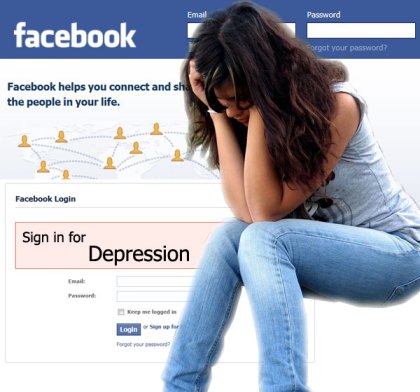While there are many things we might desire in a relationship – such as healthy communication, empathy, mutual respect and understanding, encouragement and support – excessive Facebook use is probably not one of them.
And in fact, for new couples, it can be predictive of conflict.
Surveying Facebook users ages 18 to 82 years old, researchers asked them to describe how often they used Facebook and how much, if any, conflict arose between their current or former partners as a result of Facebook use.
The results were convincing. Facebook use among couples significantly predicted Facebook-related conflict, and significantly predicted negative relationship outcomes such as cheating, breakup, and divorce (Clayton et al., 2016).
Clayton explains, “Previous research has shown that the more a person in a romantic relationship uses Facebook, the more likely they are to monitor their partner’s Facebook activity more stringently, which can lead to feelings of jealousy. Facebook-induced jealousy may lead to arguments concerning past partners. Also, our study found that excessive Facebook users are more likely to connect or reconnect with other Facebook users, including previous partners, which may lead to emotional and physical cheating” (Clayton, 2016, paragraph 4).
And this trend was particularly apparent in newer relationships. “These findings held only for couples who had been in relationships of three years or less,” notes Clayton (Clayton, 2016, paragraph 5). On the other hand, for participants who have been in relationships for longer than three years Facebook use did not appear to be related to conflict or predictive or breakups or divorce (Clayton et al., 2016).
“Facebook may be a threat to relationships that are not fully matured” (Clayton, 2016, paragraph 6).
While Facebook is a wonderful way to connect, it might not be the best thing for our new relationships. A better option, notes Clayton, is that we learn about our partners by spending time engaged with one other, communicating, and enjoying activities together – all while curtailing our Facebook use.
—
Related Online Continuing Education (CE) Courses:
 Finding Happiness: Positive Interventions in Therapy is a 4-hour online continuing education (CE) course that explores the concept of happiness, from common myths to the overriding factors that directly increase our feelings of contentment.
Finding Happiness: Positive Interventions in Therapy is a 4-hour online continuing education (CE) course that explores the concept of happiness, from common myths to the overriding factors that directly increase our feelings of contentment.
We will start with a discussion on why you, the clinician, need to know about happiness and how this information can help in your work with clients. We will then uncover mistakes we make when trying to attain happiness and look carefully at the actions we take and the beliefs that do not just obfuscate our happiness efforts, but often leave us less happy. Next, we will explore the ways in which our mindset influences our feelings of happiness and the many ways we can fundamentally change our levels of well-being, not just immediately, but for many years to come. The final section of this course contains exercises you can use with clients to cultivate and sustain a lifelong habit of happiness. Course #40-45 | 2018 | 57 pages | 25 posttest questions
 Ethics and Social Media is a 2-hour online continuing education (CE) course that examines the use of Social Networking Services (SNS) on both our personal and professional lives. Is it useful or appropriate (or ethical or therapeutic) for a therapist and a client to share the kinds of information that are routinely posted on SNS like Facebook, Twitter, and others? How are psychotherapists to handle “Friending” requests from clients? What are the threats to confidentiality and therapeutic boundaries that are posed by the use of social media sites, texts, or tweets in therapist-client communication?
Ethics and Social Media is a 2-hour online continuing education (CE) course that examines the use of Social Networking Services (SNS) on both our personal and professional lives. Is it useful or appropriate (or ethical or therapeutic) for a therapist and a client to share the kinds of information that are routinely posted on SNS like Facebook, Twitter, and others? How are psychotherapists to handle “Friending” requests from clients? What are the threats to confidentiality and therapeutic boundaries that are posed by the use of social media sites, texts, or tweets in therapist-client communication?
The purpose of this course is to offer psychotherapists the opportunity to examine their practices in regard to the use of social networking services in their professional relationships and communications. Included are ethics topics such as privacy and confidentiality, boundaries and multiple relationships, competence, the phenomenon of friending, informed consent, and record keeping. A final section offers recommendations and resources for the ethical use of social networking and the development of a practice social media policy. Course #20-75 | 2016 | 32 pages | 15 posttest questions
 Codependency: Causes, Consequences and Cures is a 3-hour online continuing education (CE) course that offers strategies for therapists to use in working with codependent clients. The author offers in-depth and in-person strategies for therapists to use in working with clients who present with the characteristic behavior patterns of codependency. Clients are usually unaware of the underlying codependency that is often responsible for the symptoms they’re suffering. Starting with emphasis on the delicate process of building a caring therapeutic relationship with these clients, the author guides readers through the early shame-inducing parenting styles that inhibit the development of healthy self-esteem. Through personal stories and case studies, the author goes on to describe healing interventions that can help clients identify dysfunctional patterns in relationships, start leading balanced lives and connecting with others on a new and meaningful level. Evaluative questionnaires, journaling assignments and other exercises are included to help you help your clients to overcome codependency. The rewards of successfully treating codependency are great for client and clinician alike. Even though the propensity for relapse always exists, it’s unlikely that a person who has made significant progress towards overcoming this disease will lose the gains they’ve made. Course #30-83 | 2015 | 40 pages | 21 posttest questions
Codependency: Causes, Consequences and Cures is a 3-hour online continuing education (CE) course that offers strategies for therapists to use in working with codependent clients. The author offers in-depth and in-person strategies for therapists to use in working with clients who present with the characteristic behavior patterns of codependency. Clients are usually unaware of the underlying codependency that is often responsible for the symptoms they’re suffering. Starting with emphasis on the delicate process of building a caring therapeutic relationship with these clients, the author guides readers through the early shame-inducing parenting styles that inhibit the development of healthy self-esteem. Through personal stories and case studies, the author goes on to describe healing interventions that can help clients identify dysfunctional patterns in relationships, start leading balanced lives and connecting with others on a new and meaningful level. Evaluative questionnaires, journaling assignments and other exercises are included to help you help your clients to overcome codependency. The rewards of successfully treating codependency are great for client and clinician alike. Even though the propensity for relapse always exists, it’s unlikely that a person who has made significant progress towards overcoming this disease will lose the gains they’ve made. Course #30-83 | 2015 | 40 pages | 21 posttest questions
—
Professional Development Resources is a nonprofit educational corporation 501(c)(3) organized in 1992. We are approved to sponsor continuing education by the American Psychological Association (APA); the National Board of Certified Counselors (NBCC); the Association of Social Work Boards (ASWB); the American Occupational Therapy Association (AOTA); the American Speech-Language-Hearing Association (ASHA); the Commission on Dietetic Registration (CDR); the Alabama State Board of Occupational Therapy; the Florida Boards of Social Work, Mental Health Counseling and Marriage and Family Therapy, Psychology & School Psychology, Dietetics & Nutrition, Speech-Language Pathology and Audiology, and Occupational Therapy Practice; the Georgia State Board of Occupational Therapy; the New York State Education Department’s State Board for Mental Health Practitioners as an approved provider of continuing education for licensed mental health counselors (#MHC-0135); the Ohio Counselor, Social Worker & MFT Board and Board of Speech-Language Pathology and Audiology; the South Carolina Board of Professional Counselors & MFTs; the Texas Board of Examiners of Marriage & Family Therapists and State Board of Social Worker Examiners; and are CE Broker compliant (all courses are reported within a few days of completion).




















